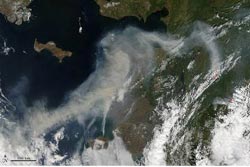Wilfire smoke over Alaska

On June 19, 2013, the Moderate Resolution Imaging Spectroradiometer on NASA's Aqua satellite captured this image of smoke from wildfires burning in western Alaska. The smoke was moving west over Norton Sound. (The center of the image is roughly 163° West and 62° North.) Red outlines indicate hot spots where MODIS detected unusually warm surface temperatures associated with fire.<br><br>Credit: NASA image by Jeff Schmaltz, LANCE/EOSDIS Rapid Response. Caption by Adam Voiland.<br>
The smoke was moving west over Norton Sound. (The center of the image is roughly 163° West and 62° North.)
Red outlines indicate hot spots where MODIS detected unusually warm surface temperatures associated with fire.
According to an advisory released by the Alaska Interagency Coordination Center, record heat and dry fuels have produced record-setting fire potential across boreal spruce forests and tundra landscapes.
The heat wave is the product of an intense ridge of high pressure over the state.
Media Contact
More Information:
http://www.nasa.govAll latest news from the category: Earth Sciences
Earth Sciences (also referred to as Geosciences), which deals with basic issues surrounding our planet, plays a vital role in the area of energy and raw materials supply.
Earth Sciences comprises subjects such as geology, geography, geological informatics, paleontology, mineralogy, petrography, crystallography, geophysics, geodesy, glaciology, cartography, photogrammetry, meteorology and seismology, early-warning systems, earthquake research and polar research.
Newest articles

Rocks with the oldest evidence yet of Earth’s magnetic field
The 3.7 billion-year-old rocks may extend the magnetic field’s age by 200 million years. Geologists at MIT and Oxford University have uncovered ancient rocks in Greenland that bear the oldest…

Decisive breakthrough for battery production
Storing and utilising energy with innovative sulphur-based cathodes. HU research team develops foundations for sustainable battery technology Electric vehicles and portable electronic devices such as laptops and mobile phones are…

Superradiant atoms could push the boundaries of how precisely time can be measured
Superradiant atoms can help us measure time more precisely than ever. In a new study, researchers from the University of Copenhagen present a new method for measuring the time interval,…





















